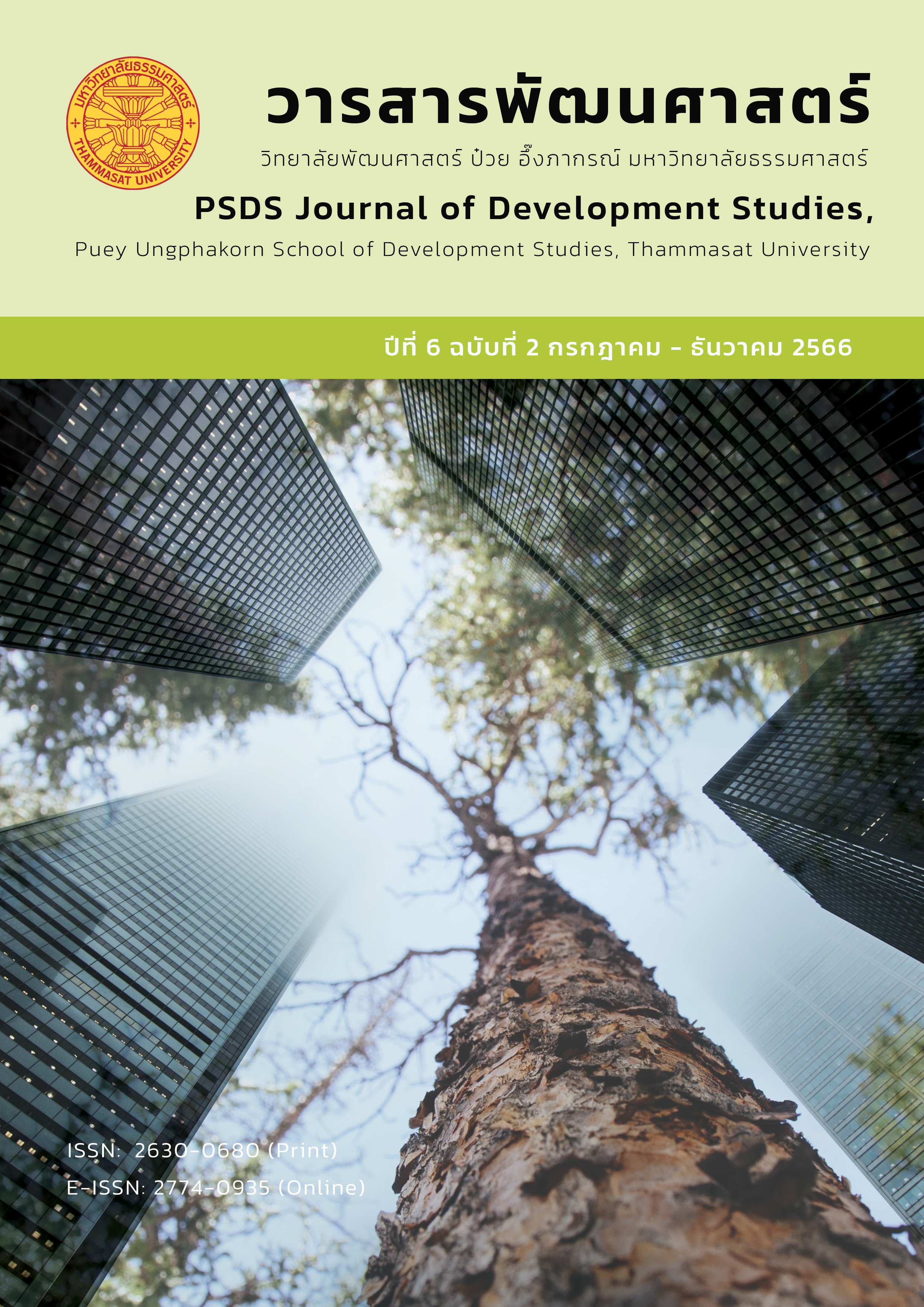ภาวะผู้นำสาธารณะแนวใหม่กับการพัฒนาสังคมในศตวรรษที่ 21
คำสำคัญ:
ภาวะผู้นำสาธารณะแนวใหม่, การพัฒนาสังคม, ศตวรรษที่ 21บทคัดย่อ
การเปลี่ยนแปลงทางโครงสร้างเศรษฐกิจและสังคมที่กำลังจะเกิดขึ้นจำเป็นต้องมีภาวะผู้นำที่มีวิสัยทัศน์ที่กว้างขวางที่สามารถนำพาสังคมไปสู่ผลสำเร็จได้ ภาวะผู้นำสาธารณะแนวใหม่ (New Public Leadership) ถูกเสนอเป็นเครื่องมือสำคัญต่อการพัฒนาสังคมเป็นบุคคลทำงานเพื่อส่วนร่วม ได้แก่ ผู้มีส่วนในการกำหนดนโยบายทางการเมืองและผู้ที่ทำงานองค์กรสาธารณะทั้งภาครัฐและภาคเอกชนขนาดใหญ่และขนาดเล็กที่มุ่งสร้างประโยชน์ต่อสาธารณะ หลังจากได้มีการนำแนวคิดการจัดการภาครัฐแนวใหม่
(New public management : NPM) ที่ได้นำมาใช้กับการจัดการภาครัฐมุ่งเน้นการสร้างความพึงพอใจของประชาชน มองประชาชนเป็นลูกค้า หน่วยงานภาครัฐต้องสร้างตัวชี้วัดเพื่อการเปลี่ยนแปลง การบริหารงานภาครัฐที่ปรับเปลี่ยนโครงสร้างการทำงานให้มีประสิทธิภาพ โดยแสวงหาผู้นำสาธารณะแนวใหม่เพื่อมุ่งเน้นการเปลี่ยนแปลงองค์กรให้ตอบสนองทิศทางการพัฒนาประเทศ ภาครัฐจึงพยายามพัฒนาภาวะผู้นำสาธารณะที่เข้มแข็ง มีทักษะการแก้ปัญหาอย่างรอบด้าน มีความคิดสร้างสรรค์ มีวิสัยทัศน์ พร้อมที่จะปรับตัวให้ทันต่อการเปลี่ยนแปลง การพัฒนาสังคมในศตวรรษที่ 21 นั้นไม่ได้มุ่งเน้นเพียงการเติบโตทางเศรษฐกิจเท่านั้น
แต่ให้ความสำคัญกับความเท่าเทียมของสังคม พร้อมทั้งได้มีแนวคิดการจัดการภาคีสาธารณะ (New public governance : NPG) เข้ามาแทนที่การจัดการภาครัฐแนวใหม่ (New public management : NPM) บทบาทภาวะผู้นำสาธารณะแนวใหม่จึงทำหน้าที่ประสานเครือข่าย สร้างความร่วมมือกับทุกภาคส่วน ส่งเสริมให้ประชาชนเป็นพลเมือง เน้นการปรึกษาหารือและการนำเสนอความคิดเห็นของประชาชนโดยตรง
การให้บริการสาธารณะอย่างมืออาชีพ เพื่อพัฒนาความเป็นอยู่ที่ดีของประชาชน ควบคู่กับการดูแลสิ่งแวดล้อม และการพัฒนาเศรษฐกิจอย่างยั่งยืน ผู้เขียนจึงได้นำเสนอหลักการ POJAI เพื่อพัฒนาภาวะผู้นำสาธารณะแนวใหม่ (New Public Leadership) กับการพัฒนาสังคมในศตวรรษที่ 21 ได้แก่ 1. P: Purposeful ความตั้งใจ
2. O: Output and Outcome ทำงานให้เกิดผลผลิตและผลลัพธ์ต่อส่วนรวม 3. J: Justice ความยุติธรรมทุกภาคส่วน 4. A: Administration บริหารงานอย่างมีประสิทธิภาพ 5. I: Impression สร้างความประทับใจต่อผู้ตามหรือประชาชน ดังนั้นภาวะผู้นำสาธารณะแนวใหม่นับมีบทบาทสำคัญต่อการพัฒนาสังคมให้เกิดความมั่นคง มั่งคั่ง และยั่งยืน
Downloads
เอกสารอ้างอิง
ปิยะพงษ์ ทองดี. (2561). ภาวะผู้นำขององค์การสมัยใหม่. วารสารร่มพฤกษ์ มหาวิทยาลัยเกริก. 36(1), 67-87.
พระมหาวรพงศ์ กุสลชโย และธิติวุฒิ หมั่นมี. (2561). ภาวะผู้นำในการบริหารองค์กรยุค 4.0. วารสารสมาศิษย์เก่า มหาวิทยาลัยมหาจุฬาลงกรณราชวิทยาลัย, 6(1), 1-13.
รักเกียรติ หงษ์ทอง และ ธนพงษ์ อุดมทรัพย์. (2559). ภาวะผู้นำเชิงวิสัยทัศน์ในบริบทการนำการเปลี่ยนแปลง. วารสารมนุษยสังคมปริทัศน์. 18(2), 73-87.
วรวรรษ เทียมสุวรรณ วัชรพล วิบูลยศริน ศิโรจน์ ผลพันธิน และเหม ทองชัย. (2562). ภาวะผู้นำเชิงกลยุทธ์ศตวรรษที่ 21. วารสารบัณฑิตวิทยาลัย มหาวิทยาลัยสวนดุสิต. 15(2), 219-231.
ศิริรักษ์ บุญพร้อมรักษา คมสันต์ ธีระพืช และวิชุดา จันทร์เวโรจน์. (2564). บทบาทของผู้นำยุคใหม่ที่มีผลต่อการจัดการองค์การบนฐานวิถีชีวิตใหม่. วารสารวิทยาการจัดการปริทัศน์. 23(2), 257-266.
อุทิศ ทาหอม และ สุจิตรา ยางนอก. (2562). แนวทางการพัฒนาเพิ่มทักษะองค์ความรู้สู่การเป็นนักพัฒนาอัจฉริยะ (Smart Developer) ของนักศึกษาสาขาวิชาการพัฒนาสังคม คณะมนุษยศาสตร์และสังคมศาสตร์ มหาวิทยาลัยราชภัฏบุรีรัมย์. วารสารวิจัยและพัฒนา มหาวิทยาลัยราชภัฏบุรีรัมย์. 14(2), 85-98.
Abdulai, D., Knauf, O., & O’Riordan, L. (2020). Achieving sustainable development goals 2030
in Africa: A critical review of the sustainability of western approaches. The Future of the UN Sustainable Development Goals. 3-44. https://doi.org/10.1007/978-3-030-21154-7_1
Bjugstad, K., Thach, E. C., Thompson, K. J., & Morris, A. (2006). A fresh look at followership: A model for matching followership and leadership styles. Journal of behavioural and applied management. 7(3), 304-319. https://doi.org/10.21818/001c.16673
Blanchard, K., Hersey, P., & Dewey, J. (2001). Managing of Organisational Behaviour, Leading Human Resources. 8. Aufl. Upper Saddle River, NJ.
Brookes, S., & Grint, K. (2010). A New Public Leadership challenge?. In The New Public Leadership challenge; (pp. 1-15). Palgrave Macmillan, London. https://doi.org/10.1057/9780230277953_1
Bureau for the Senior Civil Service Ministry of the Interior and Kingdom Relations. (2017). Vision of Public Leadership the Netherlands Senior Civil Service. Victoria University of Wellington,
Buss, T. F., Morse, R. S., & Kinghorn, C. M. (Eds.). (2007). Transforming public leadership for the 21st century. ME Sharpe. https://cplg.sog.unc.edu/publication/transforming-public-leadership-for-the-21st-
century/
ÇETIN, S. (2012). Leadership in public sector: A brief appraisal. Dumlupınar Üniversitesi Sosyal Bilimler Dergisi. (32). https://dergipark.org.tr/tr/pub/dpusbe/issue/4774/65749
Drechsler, W. (2009).The rise and demise of the New Public Management: Lessons and opportunities for South East Europe. Admin., 7, 7. https://core.ac.uk/download/pdf/280492347.pdf
Eppel, E. Hodder, P and Karacaoglu, G. (2019). New Zealand Public Sector Leadership in the 21st Century: Challenges and Opportunities. Wellington, https://cdi.mecon.gob.ar/bases/docelec/oecd/4201121.pdf
Kelley, R. E. (2008). Rethinking followership. The art of followership: How great followers create great leaders and organizations. 5-16. https://www.amazon.com/Art-Followership-Followers-Leaders-
Organizations/dp/0787996653
Klatt, M. H. B. (2001). THE ENCYCLOPEDIA OF LEADERSHIP A PRACTICAL GUIDE TO POPULAR
LEADERSHIP THEORIES AND TECHNIQUES/Murray Hiebert & Bruce Klatt/2001 McGraw-Hill.
McGraw-Hill.https://www.amazon.com/Encyclopedia-Leadership-Practical-Theories-Techniques/dp/0071363084
Murphy, S. E., & Riggio, R. E. (2003). Introduction to the future of leadership development. In The future of leadership development (pp. 27-34). Psychology Press.
Rogers, P. P., Jalal, K. F., & Boyd, J. A. (2012). An introduction to sustainable development.
Routledge. https://www.amazon.com/Introduction-Sustainable-Development-Routledge-Perspectives/dp/0415590736
Sindane, A. M. (2011). Values and ethics enter the real world: a framework for public leadership
and governance. Koers: Bulletin for Christian Scholarship= Koers: Bulletin vir Christelike
Wetenskap. 76(4), 751-769.https://journals.co.za/doi/abs/10.10520/EJC126369
Skog, D. A., Wimelius, H., & Sandberg, J. (2018). Digital disruption. Business & Information
Systems Engineering. 60(5), 431-437. https://link.springer.com/article/10.1007/s12599-018-0550-4
Vinokur-Kaplan, D. (2017). New Public Governance, Social Services, and the Potential of Co-Located Nonprofit Centers for Improved Collaborations. In Nonprofit Policy Forum. 8 (4), 445-464 https://doi.org/10.1515/npf-2017-0040
Wankhade, P., & Brinkman, J. (2007). New public management and leadership: Whether there is any contingent relationship between leadership style and performance status: Evidence from an English National Health Service (NHS) Trust. The Third Transatlantic Dialogue. May.
ดาวน์โหลด
เผยแพร่แล้ว
รูปแบบการอ้างอิง
ฉบับ
ประเภทบทความ
สัญญาอนุญาต
ลิขสิทธิ์ (c) 2023 อุทิศ ทาหอม

อนุญาตภายใต้เงื่อนไข Creative Commons Attribution-NonCommercial-NoDerivatives 4.0 International License.






